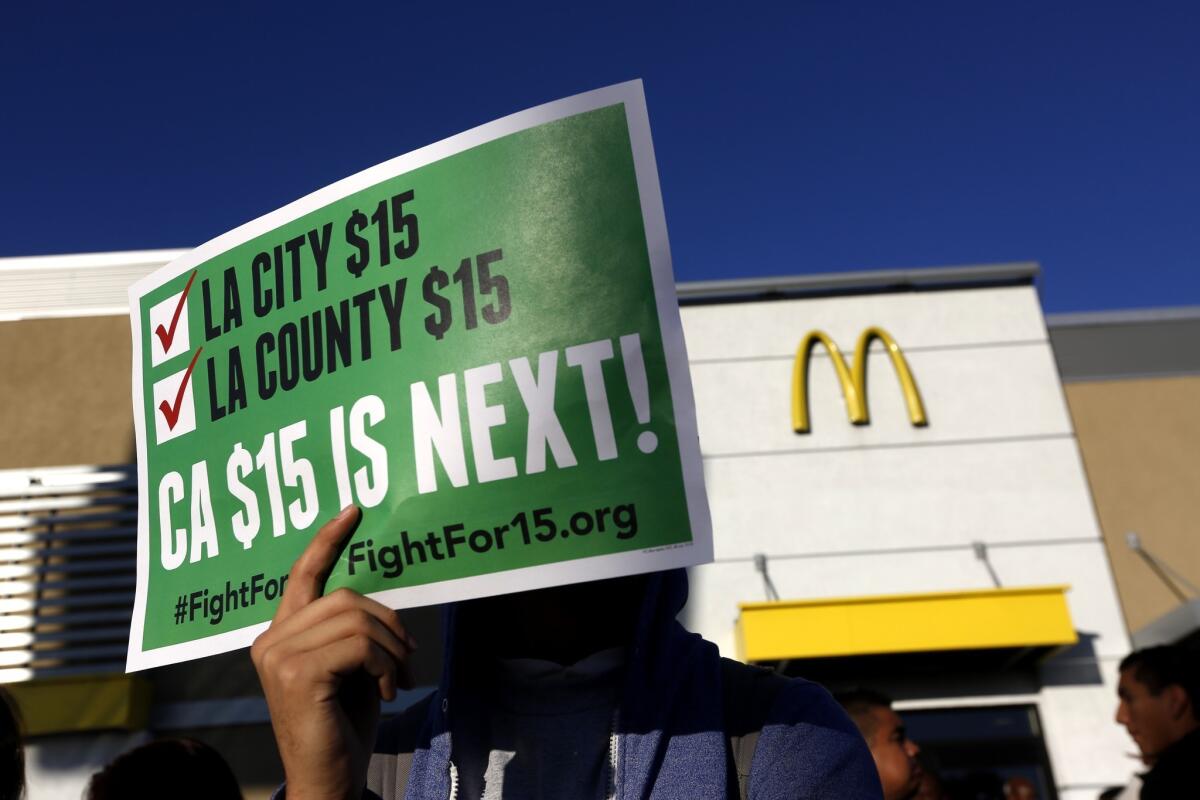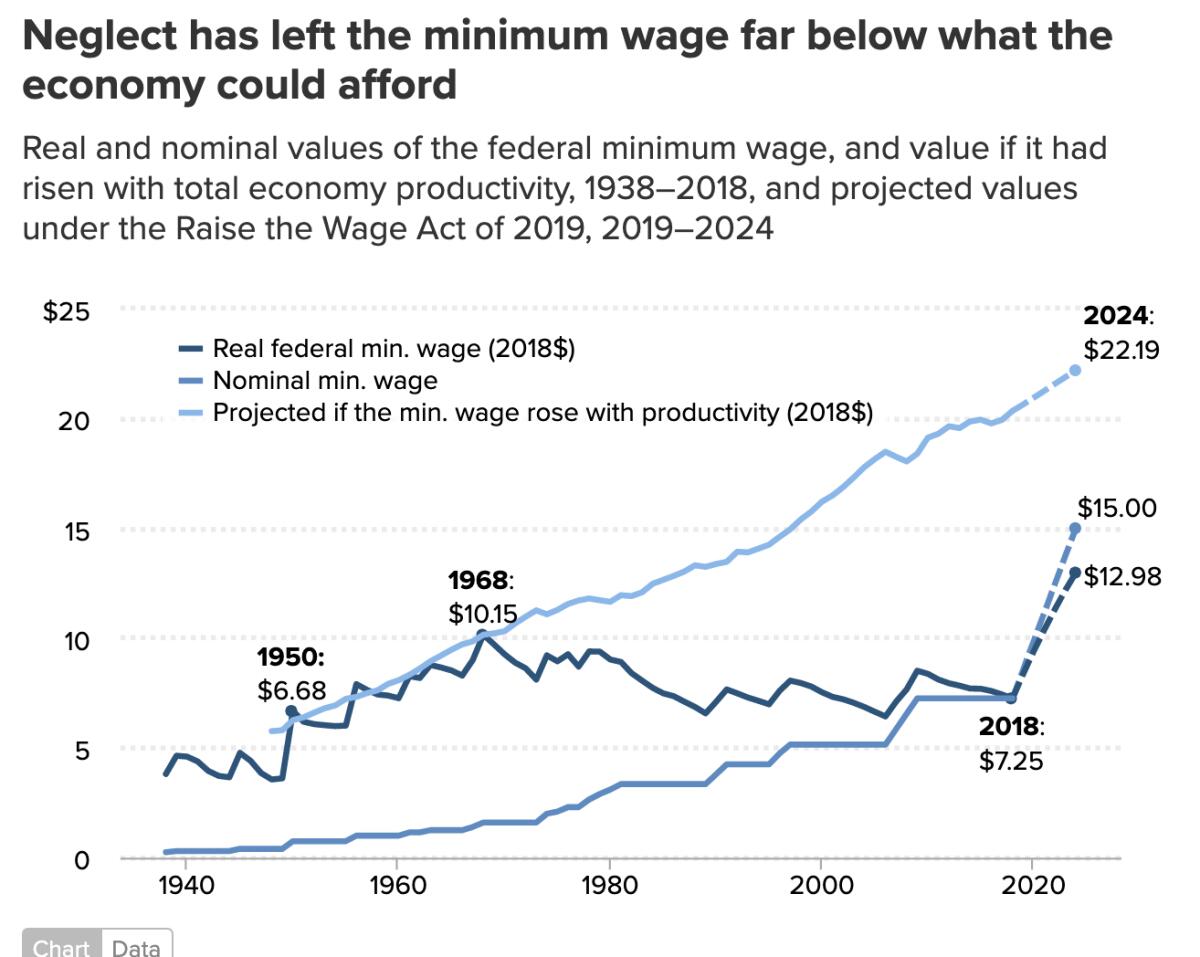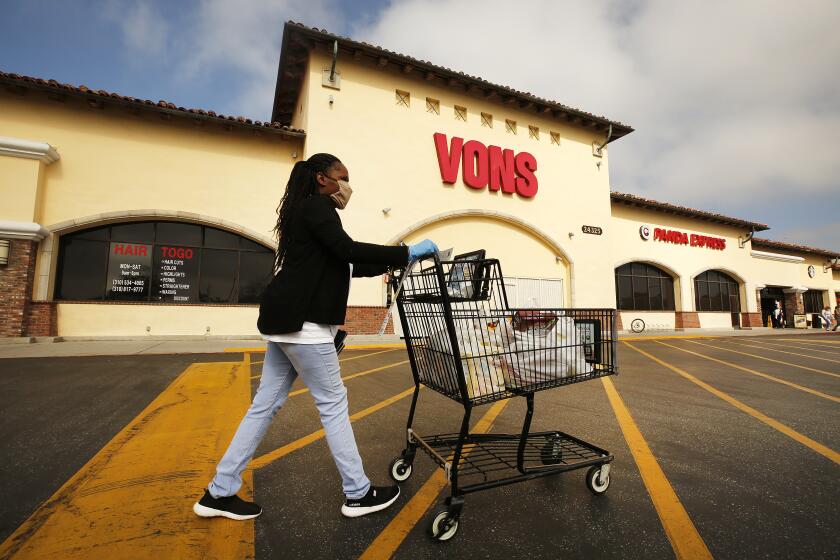Column: CBO attacks plan for higher minimum wage — or does it?

- Share via
As a proposal to increase the federal minimum wage gains steam on Capitol Hill, the Congressional Budget Office on Monday issued a new analysis of the plan that, on the surface, said it would be costly for the federal budget and some workers.
But also, on the surface, said it would be massively positive for many more millions of workers and possibly for the federal budget.
That sounds like a muddle, and so it is. Unsurprisingly, critics of raising the minimum wage call the report “devastating.” (That’s the view of the Employment Policies Institute, a front group for the restaurant, hotel, liquor and tobacco industries.)
When low-wage workers get a livable wage, they put it to good use, to improve their living standards and that of their families.
— Michael Reich, UC Berkeley economist
Proponents focused on the positives in the analysis. “CBO finds that for a very small relative cost to the government, the benefits of the Raise the Wage Act are enormous,” Heidi Shierholz, director of policy at the pro-labor Economic Policy Institute, said during a conference call scheduled Monday by her organization.
“It will increase the average incomes of low- and lower-middle-income families, it will reduce poverty, it will shift money from corporate profits toward wages of low-income workers, it will reduce inequality,” Shierholz said.
These views might seem to balance themselves out. But they don’t. A look deeper into the CBO report reveals that, in balance, the nonpartisan advisory arm for Congress finds a lot more to like about raising the minimum wage than to dislike.
That should boost the proposal’s fortunes in the Democratic Congress, which is debating not only if the act should be passed at all, but whether it can be done through the legislative maneuver known as reconciliation, which circumvents the obstacle of a Senate filibuster.
The Congressional Budget Office, that nonpartisan arbiter of the impacts of federal legislation, reports that raising the federal minimum wage to $15 an hour would increase the wages of 27 million Americans and lift 1.3 million out of poverty as of 2025.
The specific subject of the CBO study is the Raise the Wage Act, a Democratic proposal that would raise the federal minimum wage in stages from its current $7.25 an hour to $15 in 2025. After that, the minimum would be tied to increases in the median wage of all workers.
Let’s look at the CBO’s bottom line and work upward.
The CBO estimates that the act would increase the federal deficit by about $54 billion over 10 years. That sounds like a big number, but it comes to an increase of about 16 hundredths of a percent over the current deficit of about $3.3 trillion, which of course has been pumped up by anti-pandemic relief spending. But it’s also less than 1% of the pre-pandemic deficit, which was running at about $560 billion per year.
By 2025, when the minimum wage is fully phased in, the CBO says the act will have raised the wages of 17 million workers who would otherwise have been paid less than $15 an hour, and another 10 million who were earning slightly more than the minimum but whose pay would be pushed up somewhat.
Some 900,000 people would be raised out of poverty. On the downside, employment would be lower by about 1.4 million.
The so-called disemployment effect is the focus of the critiques from the industry front. But it’s challenged by the act’s proponents. They say CBO effectively cooked the books by giving too much weight to economic analyses that posit a disemployment effect, and that economists generally find little or nothing in the way of job losses from higher minimum wages.
That’s true, but the critics’ comeback is that America has never undertaken a minimum-wage increase as large as the one contemplated by the act. In Seattle, which moved rapidly toward a $15 minimum starting in 2017, the evidence is nuanced at best.

Studies by a University of Washington team have found that overall employment in the Seattle restaurant industry, the most-affected sector, has remained steady, but that experienced workers did best, inexperienced workers broke even and those just beginning to enter the low-wage job market found it harder to get a foothold.
The supposed rapidity of the act’s move to a $15 minimum is misleading, however. That’s because the real minimum wage, which peaked in inflation-adjusted terms at $10.75 (in 2020 dollars) in 1968 has been eaten away by inflation and by the shift in economic gains from workers to corporations and their owners.
Had the minimum kept pace with gains in economic productivity since the late 1960s, the Economic Policy Institute calculates, it would be worth $21.25 this year and we wouldn’t be talking about how steep an increase is needed to restore minimum-wage workers’ share of the economy to what it was six decades ago.
Employers, however, have become addicted to cheeseparing wages for their lowest-paid workers, so any such increase provokes sticker shock. Those are six decades of stagnant pay for workers at the lowest rungs of the wage ladder.
The CBO’s estimate of federal budget costs finds the bulk of the increase in government healthcare programs. Subsidies for enrollees in Affordable Care Act health plans would increase, because more families would qualify for those plans by moving out of Medicaid.
Spending on Medicaid and Medicare would increase, the CBO conjectures, in part because of higher wages for the low-income workers in healthcare. That points to an oft-overlooked aspect of the American healthcare system — it depends on some of our lowest-paid workers.
The idea that so much of the healthcare workforce is so poorly compensated that a raise in the minimum wage to $15 an hour would have a material effect on costs should be a source of shame.
In general, the CBO report paints a picture of an healthier U.S. economy as a result of the higher minimum wage. Low-wage workers would earn more, reducing demand for government assistance such as the earned income tax credit and food stamps.
Albertsons takes the lead in showing how Proposition 22 is eliminating good jobs.
More workers would qualify for Social Security (and pay for it via the payroll tax). Income would be redistributed from capital toward labor — a good trend for federal revenues, since “labor income tends to be more heavily taxed” than capital.
One aspect of the change that the CBO devotes too little attention to is that the higher wages paid to low-income workers don’t disappear into the void. They’re spent, to a greater extent than income collected by better-paid workers. Increasing the market for staples and discretionary merchandise and services is good for the economy, not a drag.
“When low-wage workers get a livable wage, they put it to good use, to improve their living standards and that of their families,” UC Berkeley economist Michael Reich, a proponent of a higher minimum wage, said on the conference call.
“They’ll spend more on some items and less on others. Workers use paychecks to buy more food for their families, instead of using food stamps,” Reich said. He estimates that federal spending on social safety net programs such as food stamps, rent assistance and the earned income tax credit will fall by about $32 billion a year.
Workers age 62 and older will tend to stay longer in the workforce, because pay will be better. That will relieve pressure on Social Security.
Undoubtedly, the CBO report will be put through the political wringer as the debate over increasing the minimum wage continues. But a deep dive into its specifics points to the same conclusion as the CBO’s analysis of an earlier version of the Raise the Wage Act, in 2019. Bringing the federal minimum wage up to date isn’t merely an option for government policy-makers, but essential.
More to Read
Inside the business of entertainment
The Wide Shot brings you news, analysis and insights on everything from streaming wars to production — and what it all means for the future.
You may occasionally receive promotional content from the Los Angeles Times.












